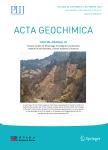Reviews in Garnet-Biotite Geothermometer: Its Versions, Inherent Problems of Accuracy and Precision, and Perspective for Further Research
Reviews in Garnet-Biotite Geothermometer: Its Versions, Inherent Problems of Accuracy and Precision, and Perspective for Further Research作者机构:LTELaboratoryInstituteofGeologyChineseAcademyofSciencesBeijing100029 LTELaboratoryInstituteofGeo
出 版 物:《Chinese Journal Of Geochemistry》 (中国地球化学学报)
年 卷 期:1999年第18卷第1期
页 面:54-61页
核心收录:
学科分类:0709[理学-地质学] 070901[理学-矿物学、岩石学、矿床学] 07[理学]
基 金:SupportedbyNationalandCASTibetResearchProject!(KZ95 1 A1 2 0 4 0 1 0 4)
摘 要:This paper briefly introduces twenty one versions of garnet biotite Fe Mg exchange geothermometry, points out the sources of systematic errors inherent in geothermometry. The sources lie in that: (1) ideal Fe Mg mixing in garnet and biotite is assumed; (2) non ideal properties of both garnet and biotite are not considered completely; (3) minor elements—Mn, Ca in garnet, and Al Ⅵ, Ti, Mn in biotite are almost neglected; (4) effects of pressure on equilibrium, although little, are almost not taken into consideration, and experiments were conducted at one fixed pressure; (5) the data used for regression analysis is too scarce in quantity; (6) internal consistency of the data used for empirical calibration is not fully guaranteed; (7) the authors take energy parameters W’s (Margule’s parameters) independent of pressure and temperature, though the former are actually the functions of the latter items; and (8) the most important composition activity relationship is not consistent with the mineral compositions used for calibration. Furthermore, it is believed that empirical calibrations cannot avoid the following problems: (1) effect of retrograde metamorphism; (2) inconsistent data set; (3) effect of pressure on temperature estimation; and (4) effect of Fe 3+ calculation. Exact experimental work should be done in order to accurately calibrate the geothermometer in which the Margule’s parameters should be treated as the functions of pressure, temperature, and mineral compositions.



